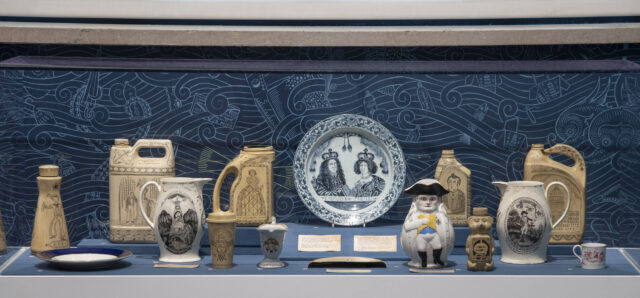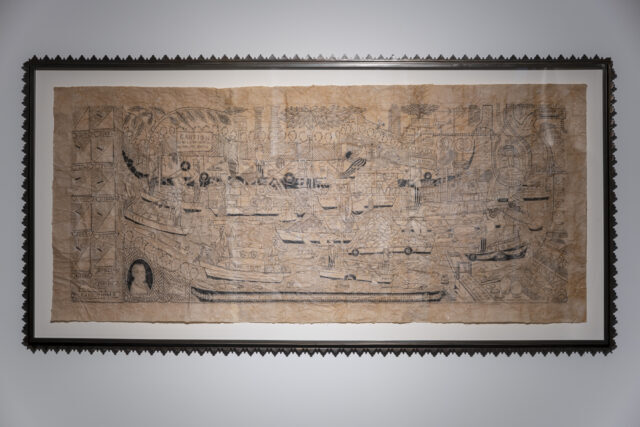
Duke Riley exhibition at the Brooklyn Museum features hundreds of maritime-related existing artwork and painted salvaged plastic (photo courtesy of the artist)
Who: Duke Riley, Kizzy Charles-Guzman, Larissa Belcic, Michelle Shofet, Ajay Singh Chaudhary
What: Panel discussion
Where: Brooklyn Museum, 200 Eastern Pkwy. at Washington St.
When: Wednesday, November 3, $16, 7:00 (exhibition continues through April 23, 2023)
Why: For more than twenty years, Boston-born, Brooklyn-based multimedia installation artist Duke Riley has been trying to save the planet, one pigeon, one fish, and one piece of garbage at a time, creating immersive works that explore the state of the environment, with a focus on water. In 2007’s “After the Battle of Brooklyn,” he reenacted the Revolutionary War mission of the one-manned primitive submarine known as the Turtle in New York harbor. In 2012’s “The Rematch,” he restaged the mythological Chinese race that established the zodiac and the measurement of time in a yearly cycle, using a dozen gondolas with live animals, a person wearing an animal mask, and an opera singer performing a song told from the animal’s perspective. In 2013-14, “See You at the Finish Line” at Magnan Metz Gallery documented fifty homing pigeons that Riley bred and trained to travel back and forth across the Atlantic Ocean from Key West to Cuba. And in 2016’s “Fly by Night,” he trained two thousand pigeons, each fitted with a remote-controlled LED light, to soar through the sky and over the sea at the Brooklyn Navy Yard in a dazzling, glowing dance.
Continuing through April 23 at the Brooklyn Museum, Riley’s “DEATH TO THE LIVING, Long Live Trash” furthers his investigation of our relationship with the natural world. The show consists of several hundred objects, from seventeenth- to twentieth-century porcelain and earthenware with portraits and maritime themes on them to dozens of works by Riley, part of his “Poly S. Tyrene Memorial Maritime Museum” series, in which he draws intricate designs on salvaged plastic garbage — bottles, combs, frames, brushes, flip-flops, coffee cups, a Whiffle ball — echoing the craft of scrimshaw, carvings on whale bone and teeth. They are arranged in glass cases, a few horizontal ones that recall the still-lifes of Giorgio Morandi; some of the portraits are of oil, food, chemical, and plastics industries lobbyists and CEOs.
The exhibition also features the short video Wasteland Fishing, in which Riley goes fishing with lures he made out of recycled trash, many of which are on view in wall cases with such titles as Mother Ocean and Monument to Five Thousand Years of Temptation and Deception III; colorful, kaleidoscopic mosaic panels made of broken shells, cigarette butts, and other effluvia, including one with the message “Tomorrow Is a Mystery”; the videos Beach Clean Up and Newtown Creek; and interventions in the museum’s seventeenth- and eighteenth-century Jan Martense Schenck and Nicholas Schenck Houses, including a plastic chandelier and Riley’s work table. The ink-on-canary-paper The View from the Mouth of the Newtown Creek During Final Days of Battle is a heavily detailed map of boats, skeletal police, merfolk, plastic garbage, tombstones, and more, with an AR component that leads visitors to stories of the history of the polluted Newtown Creek in Brooklyn.

Duke Riley, The View from the Mouth of the Newtown Creek During Final Days of Battle, ink on canary paper, 2021 (photo courtesy of the artist)
“In 2003 I sailed a 26′ dilapidated sloop into the creek and illegally tied it up to an abandoned bulkhead, expecting to get chased off in a matter of days. As days turned into years, other boats began to appear around me and continued to do so long past my departure from the creek in 2013,” Riley explained in a label for the 2022 Biennale of Sydney, which commissioned the piece. “There are currently more than thirty derelict boats moored in the creek, mostly clustered together, with people living aboard full time. At first glance, the people that remain there are living out a romantic maritime dream. A rent-free life enviable to the rest of us caught up in the demands of living in one of the most expensive cities in the world. In reality, for most this alternate existence is coupled with harsh winters without heat and a lack of plumbing, running water, and basic amenities that many of us take for granted. The most notable downside is the continuous and potentially lethal exposure to a highly carcinogenic environment caused by living on top of a federal Superfund site. Most have no financial means to leave and live elsewhere but are constantly in fear of being told to leave in the middle of the night.”
On November 3 at 7:00, Riley will be at the museum for the special program “Brooklyn Talks: Artists and Activists on Climate Grief,” a panel discussion with NYC Mayor’s Office of Climate and Environmental Justice executive director Kizzy Charles-Guzman, Larissa Belcic and Michelle Shofet of Nocturnal Medicine, and Brooklyn Institute for Social Research executive director Ajay Singh Chaudhary, who will serve as moderator. Riley will focus on his works made of found plastic and how everyone can fight local pollution and global marine devastation. And on March 12, 2023, Riley will give a tour of the exhibition as part of the museum’s “Artist’s Eye” program.